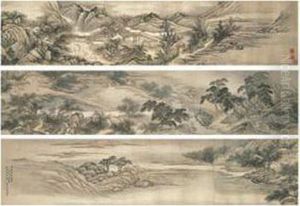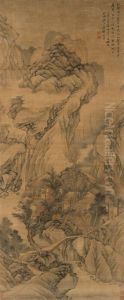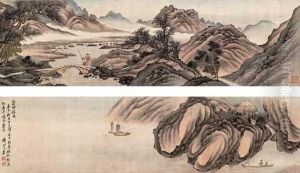Wang Gai Paintings
Wang Gai was a Chinese painter, calligrapher, and art theorist known for his contributions to the development of the Orthodox School of landscape painting during the Qing Dynasty. Born into a scholarly family in 1645, at a time when China was undergoing significant political and social changes with the fall of the Ming dynasty and the rise of the Qing, Wang Gai's work reflects the transition and the tension between the old and the new.
Wang Gai was part of a family of artists. His grandfather, Wang Shimin, and his father, Wang Jian, were both prominent painters, and they provided him with a strong foundation in the arts. Under their guidance, Wang Gai learned the importance of drawing inspiration from the works of ancient masters while also developing his own style. This philosophy is evident in his landscapes, where he often combined the brushwork techniques of past masters with his own observations of nature.
In 1679, Wang Gai, along with his father and uncle, Wang Hui, and another painter, Wang Yuanqi, co-authored the 'Manual of the Mustard Seed Garden' (Jieziyuan Huazhuan), a comprehensive guide to Chinese painting. This manual became one of the most important and widely distributed art instruction books in China, influencing generations of artists. It covered a range of subjects, including techniques for brushwork, ink use, and composition, and provided a systematic approach to painting that was both practical and philosophical.
Wang Gai's own paintings often depict traditional Chinese landscapes with mountains, rivers, and trees, executed with a refined and scholarly touch. His landscapes are characterized by their serene and harmonious qualities, showcasing the artist's skill in employing the brush and ink to express both the physical and spiritual aspects of nature. Wang Gai's work is noted for its quiet elegance and adherence to the literati tradition, which emphasized the moral and didactic functions of art.
Despite being less celebrated than some of his contemporaries, Wang Gai's contributions to Chinese art theory and practice were significant. His work, along with that of his family and colleagues, helped to define the standards of the Orthodox School and set a benchmark for scholarly painting during his era. Wang Gai's legacy continued through the spread of his teachings in the 'Manual of the Mustard Seed Garden' and through the works of subsequent artists who were influenced by his approach to landscape painting.
Wang Gai passed away in 1705, leaving behind a body of work that continues to be studied and admired for its embodiment of the traditional principles of Chinese painting. His emphasis on learning from the past while cultivating a personal style remains a cornerstone of Chinese art education.



